|
26th
January
Doonfoot,
Troon
Central Scotland was to be dull, wet and cold on Sunday. The one note
of optimism was that brighter weather would push in from the west, so
we headed for Doonfoot, south of Ayr. We stopped off at Stewartfield
Morrisons in East Kilbride for a quick breakfast (9.5/10: excellent),
before belting down the M77 to not quite sunny Ayr, but it was an
improving picture. A Greenfinch
and a Stonechat
welcomed us on arrival at the Castle Walk car park close to the
footbridge at the mouth of the River Doon - Burns country,
appropriately, as it was a day after Burns Night. We surveyed the pond
and were pleased to see some Black-headed Gulls and a dozen or so noisy
Teal.
| Greenfinch |
Female Stonechat |
Black - headed Gull |
Teal |
 |
 |
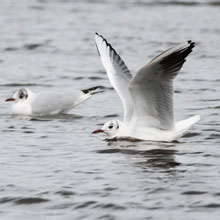 |
 |
The tide was very high
so we couldn’t access the beach so we
decided to cross the footbridge over the Doon to see what we could find
on the shoreline there. On the banks of the river were gathered a pair
of juvenile Mute Swans and around them a large flock of roosting
Redshanks. Growing near them, John spotted our first flowers of the year,
a patch of Snowdrops .
On the other side of the bridge, a pair of Stonechats (see also
“Pictures of the Week”) were sitting no more than
5m away,
high on the withered vegetation.
| Juvenile Mute Swan |
Redshank |
Common Snowdrop |
Stonechat |
 |
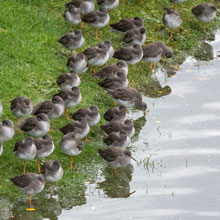 |
 |
 |
On the short parkland
grass a half dozen Rooks were feeding,
some of them squabbling over a large snail. A Common Gull circled
overhead, ready for the quick steal should the opportunity appear. A
few more Teal were dabbling in the burn mouth.
| Rook |
Common Gull |
Female Teal |
 |
 |
 |
An extensive pile of
seaweed was strewn along the shoreline and scores
of Turnstones were getting stuck in looking for invertebrates, although
they were frequently interrupted by passing dogs (see
“Pictures
of the Week”). Pied Wagtails and Rock Pipits were also
nipping
about on the seaweed. Also, John noticed a pair of Goldeneye 40m
offshore.
| Pied Wagtail |
Rock Pipit |
Goldeneye |
 |
 |
 |
We returned to the car
and made a brief visit to the Greenan Shore car
park. A quick scan produced pictures of a Swan on the sea, a wee cock
House Sparrow on a hedge and a Carrion Crow foraging in the short grass
but, on seeing that our normal route along the beach was blocked by the
high tide, we decided to cut our losses and head for Troon.
| Mute Swan |
House Sparrow |
Carrion Crow |
Starling |
 |
 |
 |
 |
At Troon we parked at
the Titchfield Road car park and walked
along the Italian Gardens to the South Beach. A Grey
Wagtail (see
“Pictures of the Week”) darted onto the
promenade
and began pecking at weeds before descending to the vast mass of
seaweed on the shore. A Cormorant flew north over very choppy waters.
Close in were a few Black-headed Gulls riding the waves, presumably
picking off invertebrates dislodged from the seaweed. A Pied Wagtail
scurried past us on the Prom as it searched for scraps to eat. I
spotted a Rock Pipit exploring a more sheltered stairwell in the sea
wall.
| Cormorant |
2nd Cycle Black - headed Gull |
Female Pied Wagtail |
Rock Pipit |
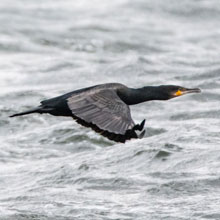 |
 |
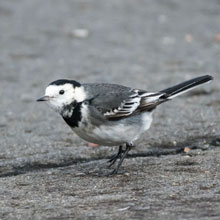 |
 |
A first-year Herring Gull
was floating in the calmer water, waiting on a
chance for food. Only metres away, a solitary Redshank (see
“Pictures of the Week”) was scouring the seaweed
pile
paying little attention to the passing crowds. Less trusting were a
flock of wary, nervous Starlings that settled for only seconds at a time
as people passed.
| 1st Cycle Herring Gull |
Starling |
 |
 |
We returned to the car
and drove to the Harbour car park. The wind was
fairly brisk as we explored the sandy area near the harbour wall. We
came across a large flock of Ringed
Plover and Dunlin
(see also “Pictures of the Week”). They
were
very unsettled by the wild waves lashing their preferred area of
shingle.
| Ringed Plover |
Dunlin |
 |
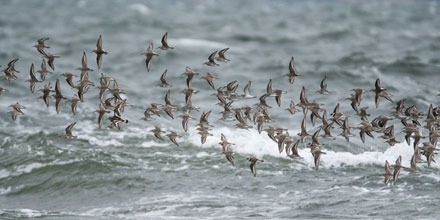 |
On rocks in front of the
car park we were delighted to see a large flock of roosting Knot.
| Knot |
 |
Unlike the Dunlin flock,
the Knot (see also “Pictures of the
Week”) were very settled, only stirring when the waves
threatened
or when Oystercatchers muscled in on their patches. A watchful Curlew
was at the edge of the rocks just out of the way of any commotion. Our
final picture was of a bird liable to cause a commotion at any time, a
Herring Gull, standing on a rooftop waiting for any chips discarded
from the many parked cars (The chips smelled lovely).
| Knot |
Oystercatcher |
Curlew |
Herring Gull |
 |
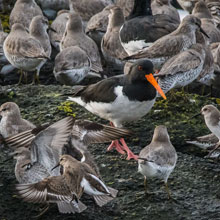 |
 |
 |
Throughout the trip the
sun never really broke through the clouds, but
the light was passable. We had plenty to photograph and our tally of
photos was pleasing. It was a successful trip which we celebrated in
the usual way by imbibing tea and nibbling chocolate coated cream
eclairs. Frustratingly, the sun came out as we started the drive home.
Typical!
Pictures of the Week:
| Female Stonechat |
Turnstone |
 |
 |
| Grey Wagtail |
Redshank |
 |
 |
| Dunlin |
Knot |
 |
 |
19th January 2020:
Stevenston Point, Saltcoats and Irvine Harbour
For the first Sunday in a
couple of months the weather prediction for
West Central Scotland was favourable, so we headed for Stevenston,
Saltcoats and Irvine. As we consumed our breakfasts in Stevenston
Morrisons (10/10, another super breakfast), it was overcast, although
we could see patches of
blue sky to the north. We hoped the cloud would clear by the time
we’d finished. However at Stevenston Point it was very gloomy
with
very few birds on view. We could see that Goat Fell on Arran has become
illuminated with sunshine so we decided to relocate to Saltcoats where
we expected it would soon become sunny. On our way off of the Point,
from the car, I snapped a Common Gull and an Oystercatcher, two of the
very many birds that were hunting worms on the large extensive areas of
mown grass.
In the middle of, a now
sunny Saltcoats Harbour, we came across a Common
Seal apparently
sleeping in the the water, or was it ill? We scanned the rocks at the end of the harbour hoping
we’d find some Purple
Sandpipers. Unfortunately not, but I got nice shots of a pair of Herring
Gulls , a 3rd year and a first year juvenile. A few
small, back-lit Shags dashed past the harbour.
| Common Seal |
3rd Cycle Herring Gull |
1st Cycle Herring Gull |
Shag |
 |
 |
 |
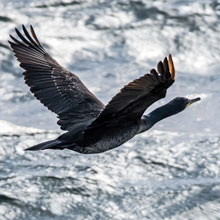 |
The stunning cloudscape,
looking south towards Ailsa Craig, just before the sun broke through:
The tide was at its
lowest so the rocks of the harbour basin were fully exposed. John
pointed out a small flock of snoozing Dunlins nestling on the rocks. We decided to walk around the
harbour to get nearer the
exposed rocks, hoping for more waders. John took a picture of a Feral
Pigeon perched inside
a drainage hole in the sea wall. He also spotted a
Curlew that was feeding on the harbour floor. On top of the wall a
rather less shy Feral
Pigeon made a lovely subject.
| Dunlin |
Feral Pigeon |
Curlew |
Feral Pigeon |
 |
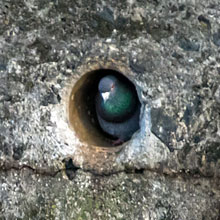 |
 |
 |
The pleasing view across
the harbour, looking towards Arran:
We continued our walk by
moving towards the North Beach. We were met
with the impressive sight of a dozen Mute Swans flying in from the North beach. They splashed down onto the
outdoor pool. On rocks adjacent to the pool I noticed a few Ringed
Plovers cowering
in the stiff cold
breeze. A bit further along the rocks a few Dunlin were also
sheltering. On our way back to the car I got some interesting shots of
an Oystercatcher
chipping Mussels off of the rocks (see “Pictures of
the Week”, below). It then made short work of removing the
contents. On the same
rock pool a Redshank was also pecking the seaweed and rocks albeit for
smaller invertebrates.
| Mute Swan |
Ringed Plover |
Dunlin |
Redshank |
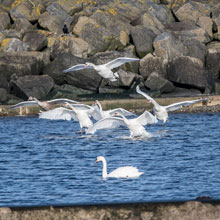 |
 |
 |
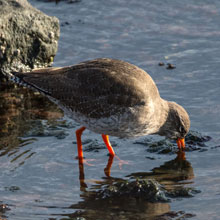 |
Our final destination was
Irvine Harbour. There were many more cars than
usual in the car park. We were a bit puzzled by that until we realised that there were crowds of people wandering
the paths looking down at
their phones. It was a Pokemon Go event. One participant told me they
were looking for a
virtual Penguin. I told her we were after real birds. Our first sighting
was a beauty, a close range drake Red-breasted
Merganser (see “Pictures of the
Week”, below). Close by we also saw a
juvenile and a female. A bit further upstream a pair of Mute Swan
cygnets were cruising
close to the bank, hoping for bread. Across the river we could
see half a dozen Wigeon, some feeding, but most were sleeping on the rocky bank.
| Juvenile Red - breasted Merganser |
Female Red - breasted Merganser |
Juvenile Mute Swan |
Wigeon |
 |
 |
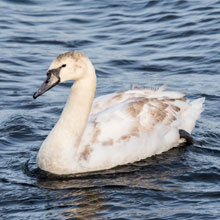 |
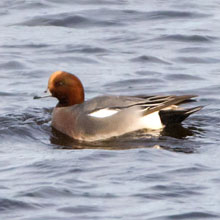 |
We walked along the
promenade to the estuary mouth. As I snapped a nice
shot of a Blackheaded Gull on a big orange buoy, a Cormorant surfaced just below where I was standing. Just beyond
the foot bridge on the
opposite bank an elegant Grey Heron stood in the low winter sunshine.
It took flight after a
time and settled on a sandy patch neared the river mouth
(see “Pictures of the Week”, below). The largest
gulls, Great
Black-backed Gulls had claimed perching rights on two mid-river metal
columns, which they guarded stubbornly.
| Black - headed Gull |
Cormorant |
Grey Heron |
Great Black - backed Gull |
 |
 |
 |
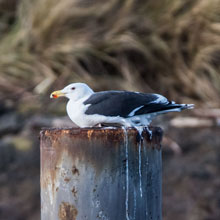 |
Four Red - breasted
Mergansers darted down stream and out of the estuary.
I managed to capture a
shot of a 2nd winter Herring Gull dropping a
shellfish onto the rocks - but missing as it was over the water! John
snapped a few pictures
of an adult Herring Gull’s attempts to access a
bundle of shellfish. Next we noticed the pair of cygnets we’d
seen
earlier flying down the
estuary. After photographing the Swans I caught a Carrion Crow flying
across the sandy shore.
| 2nd Cycle Herring Gull |
3rd Cycle herring gull |
Juvenile Mute Swan |
Carrion Crow |
 |
 |
 |
 |
The view of the mouth of
the Estuary of the Rivers Irvine and Garnock:
Satisfied with our
collection of sightings, we made away back through
the Pokemoners along towards the car. A Cormorant passed us as it
flapped ts way
toward down river and seemed to herald the arrival, low
overhead, of a large flock of Wigeon. A large Herring Gull perched on by
the pier side seemed
unimpressed. Our last sighting of the day came as we poured out the
tea. A Rook loitered around the car (see
“Pictures of the Week”, below), obviously waiting for any scraps
we’d care to offer.
| Cormorant |
Wigeon |
Herring Gull |
Rook |
 |
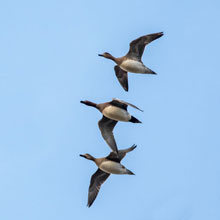 |
 |
 |
After a slow start at
Stevenston point the day certainly picked up and
by the end of our trip we had, as can be seen above, a very
satisfactory collection of pictures. Our well-earned teas and Danish
pastries were, as usual, very enjoyable - just like the trip.
Pictures Of The Week:
| Oystercatcher |
Red - breasted Merganser |
 |
 |
| Grey Heron |
Rook |
 |
 |
12th January 2020:
Musselburgh and Port Seton
We travelled east to
Musselburgh where blue skies were promised, though
a stiff cool breeze made the wooly thermals a good idea. We got off to a
fine start as Dalkeith Morrisons Cafe served up perfect breakfasts
(10/10), making up for their recent minor lapses. We first explored the
Esk by the
Millhill car park. It was fairly quiet, but the low golden
sunlight provided excellent illumination for some nice shots of a
circling adult Herring
Gull and a standing first-year Herring Gull (see
“Pictures Of The Week”, below). John noticed a
hybrid
goose, probably a
Greylag X Canada goose cross. Of course, there were also many Feral
Pigeons at the
popular feeding spot. Most of these were unremarkable but a handsome piebald caught our
attention.
| Herring Gull |
Canada X Greylag Goose |
Feral Pigeon |
Piebald Pigeon |
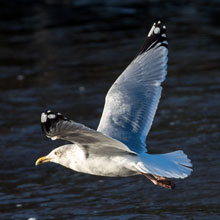 |
 |
 |
 |
I snapped a damp Canada
Goose as it posed briefly in the amber light. Behind it a pair of Goldeneyes also
caught the luscious light, before the drake suddenly flew upstream (see
“Pictures Of The Week”, below). Unusually we saw
only a
single Mute Swan.
| Canada Goose |
Drake Goldeneye |
Female Goldeneye |
Mute Swan |
 |
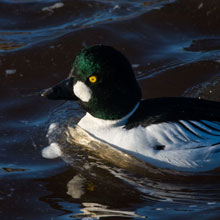 |
 |
 |
We moved to the mouth of
the River Esk where we came across tens of
Turnstones picking their way along the water’s edge. The flock
included a solitary
Dunlin. A very fine Curlew also moved along the bank
and seemed relatively unconcerned by passing pedestrians or my clicking
camera. I caught a few
shots of a juvenile drake Goldeneye that flew
upstream. It can be distinguished from the similarly-marked female by
its faint white cheek
spot (that will become much more prominent in
adulthood).
| Turnstone |
Dunlin |
Curlew |
Juvenile Male Goldeneye |
 |
 |
 |
 |
We walked east towards
the Scrapes
(or “Lagoons”, as they’re also known),
scanning the
very choppy waters. The tide was well in and many“squadrons” of
Oystercatchers (see “Pictures Of The
Week”, below) were on the move as they headed for more
sheltered
roosting spots. Near
the Scrapes a flock of over a hundred Bar-tailed
Godwits swooped and
circled over the sea. They’d obviously been disturbed in the
Scrapes, maybe by a
fox or a raptor.
From the hides all
seemed calm. There were a vast patch of stationary
Oystercatchers and some Godwits. A few Teal dabbled on the side of the pool and mid-pool a single Shelduck was working the mud.
| Oystercatcher |
Teal |
Shelduck |
 |
 |
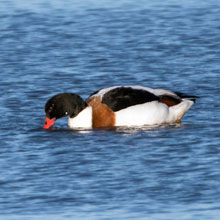 |
After an event-less
return journey to the car we decided to check out
Port Seton as it can provide close shots of waders just before the tide
is fully in. This was
the case at mouth of the Seton Burn. I got a
lovely picture of a bonny wee Turnstone (see “Pictures Of The
Week”, below) on
top of a boulder. Just offshore some Wigeon and
Mallards were feeding.
| Wigeon |
Mallard |
 |
 |
The Wrecked
Craigs were
completely submerged but we had a lovely view of Gosford
House and North
Berwick Law to
the east
To the north, across the
Firth of Forth, we watched a striking rainbow
form as the rain passed eastwards. The sky darkened and we lost the sun
for the
first time behind the advancing clouds. However, I managed one
more capture, a pair of Eiders flying west.
|
Eider |
 |
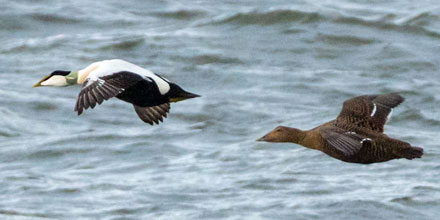 |
We took to the car for
our teas and Danish Pastries and agreed it had
been a pleasing trip. My highlight was the breathtaking aerobatics of
the Godwit flock. Well
worth the petrol money.
Pictures Of The Week:
| 1st Cycle Herring Gull |
Goldeneye |
 |
 |
| Oystercatcher |
Turnstone |
 |
 |
5th January 2020:
Barns Ness and Dunbar Harbour
It was one of those days
when the weather across Central Scotland was
to to be dry and breezy, but very dull. However, there was a chance of brightness to the east, so that’s
where we went - Barns Ness. Our
breakfast in Dalkeith Morrisons was alright (8/10) and it gave the
clouds time to break
and reveal encouraging patches of blue. As we
drove along the single track approach road towards the Barns Ness car
park, I spotted a large
flock of Greylags
on a hillock. Looking out to sea, towards the Bass Rock, the wind was
whipping up huge plumes of spray. The shore was lined with walkers and
their dogs - not a welcome sight for a nature watcher. Still, most of
the birds, such as the Rock
Pipits , returned
to what they were
doing, so we just waited for a gap in the “traffic”
before setting off.
We came across the
“usual suspects”, which I never tire of
photographing. Redshanks, Turnstones and Oystercatchers were working
the shoreline (see
also, “Pictures of there week”, below).
Mallards were also busy in the bay as the tide slowly crept out. The
shallows made easier feeding
conditions since the invertebrates the
birds were after were easier to catch.
| Redshank |
Turnstone |
Oystercatcher |
Mallard |

|

|

|

|
We settled on the sandy
beach to the east of the lighthouse to see what would pass. A huge Great
Black-backed Gull
circled above the rocky shore.
A few Curlew (see also, “Pictures
of there week”, below) flew in for a forage, and of course,
there
were plenty of Carrion Crows exploring the rock for shellfish and crabs.
| Great Black-backed Gull |
Curlew |
Carrion Crow |
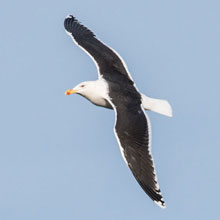
|
 |

|
John directed my
attention to a few Red
Breasted Mergansers that
were diving just offshore, but that was about it. We next crossed the
dunes and field to the
south boundary wall and old campsite. We saw no
birds there but I did come across a couple of winter blooms. We found
many Gorse
bushes, their yellow flowers reminding us of summer’s days. In
the
“ruins” of the campsite a single Horticultural
shrub, Koreanspice
viburnum, was still in
bloom, and I noticed its branches were showing signs of early growth.
| Red - breasted Merganser |
|
Gorse |
Korean Spice viburnum |

|

|

|

|
We relocated to Dunbar
Harbour. Once again there were no surprises in
what we saw. There were lots of Great Black-backed and Herring Gulls.
Sadly, “Sammy” the Grey Seal didn’t show
probably
because the fishing boats were all at sea.
| Great Black - backed Gull |
Herring Gull |
1st Cycle Herring Gull |
Great Black - backed Gull |

|

|

|

|
Off the sea wall we
watched a pair of diving
Eiders .
The drake managed to catch an unfortunate Crab. It trimmed off the legs
before swallowing its
catch, shell and all (see also, “Pictures
of there week”, below).
We made a bit of mistake
in Dunbar. We should have checked out the East Beach for the reported Black
Redstart.
I found out later that it was
showing just as we drove past the beach.
Oops! Maybe we were too eager for our end-of-trip Danish pastries.
Highlight of the trip was the Eider,
but it had been a very pleasant
walk in some very beautiful, sunlit places.
Pictures Of The Week:
| Redshank |
Turnstone |

|

|
| Oystercatcher |
Eider |

|

|
Highlights
- January 2020
Below
are some of my favourite pictures taken during January 2020 listed in
loose themes. There’s no commentary. We hope you enjoy the
photos.
FLIGHT SHOTS
| Canada
Goose |
 |
| Female Goldeneye |
Greylag Goose |
 |
 |
| Lesser Black - backed Gull |
Drake Mallard |
 |
 |
| Mute Swan |
 |
NOT BIRDS
| Jelly Ear Fungus |
Winter Heliotrope |
 |
 |
PORTRAIT
| Greylag x Swan Goose Hybrid |
Female Tufted Duck |
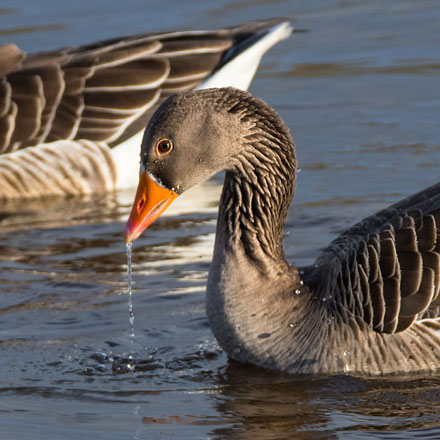 |
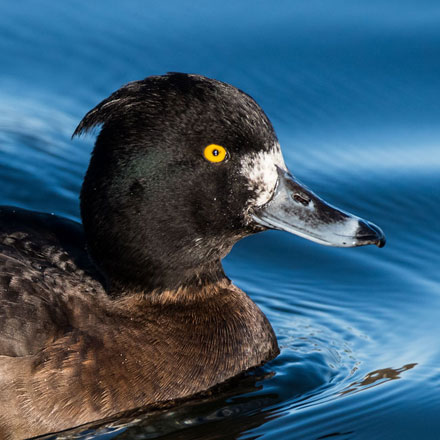 |
| Drake Tufted Duck |
Wigeon |
 |
 |
FEED THE BIRDS
| Female Bullfinch |
Male Bullfinch |
 |
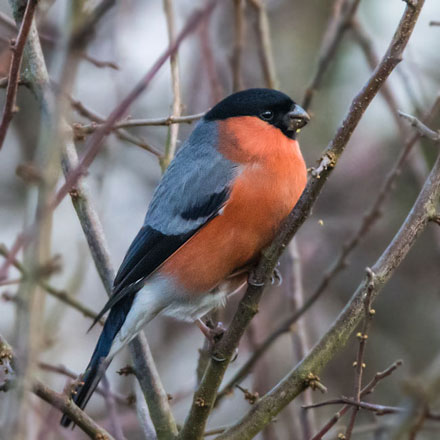 |
| Goldfinch |
Jackdaw |
 |
 |
| Oystercatcher |
Redshank |
 |
 |
WATER SHOT
| Carrion Crow |
Great Black - backed Gull |
 |
 |
| Teal |
Female Tufted Duck |
 |
 |
IN THE PARK
| Common Buzzard |
Linnet |
 |
 |
| Female Pied Wagtail |
Robin |
 |
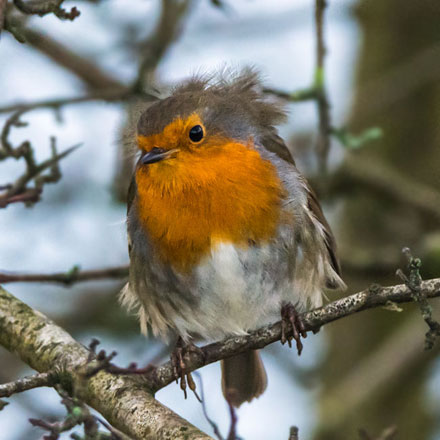 |
Back To Top
|

